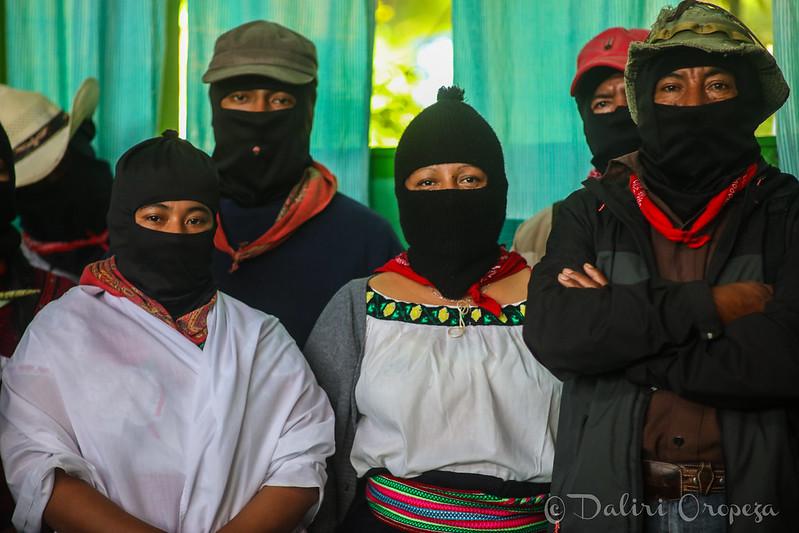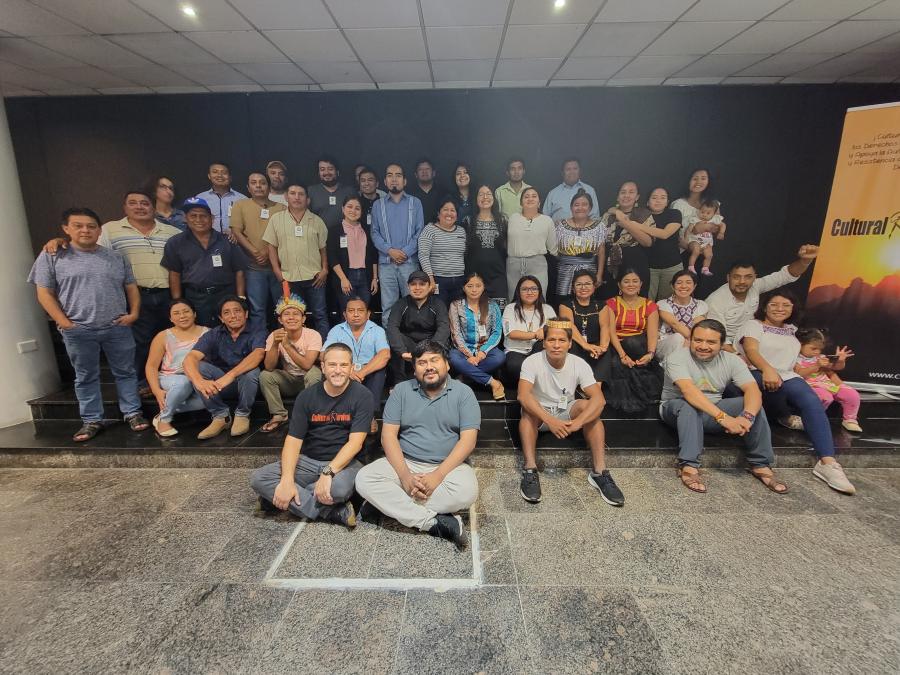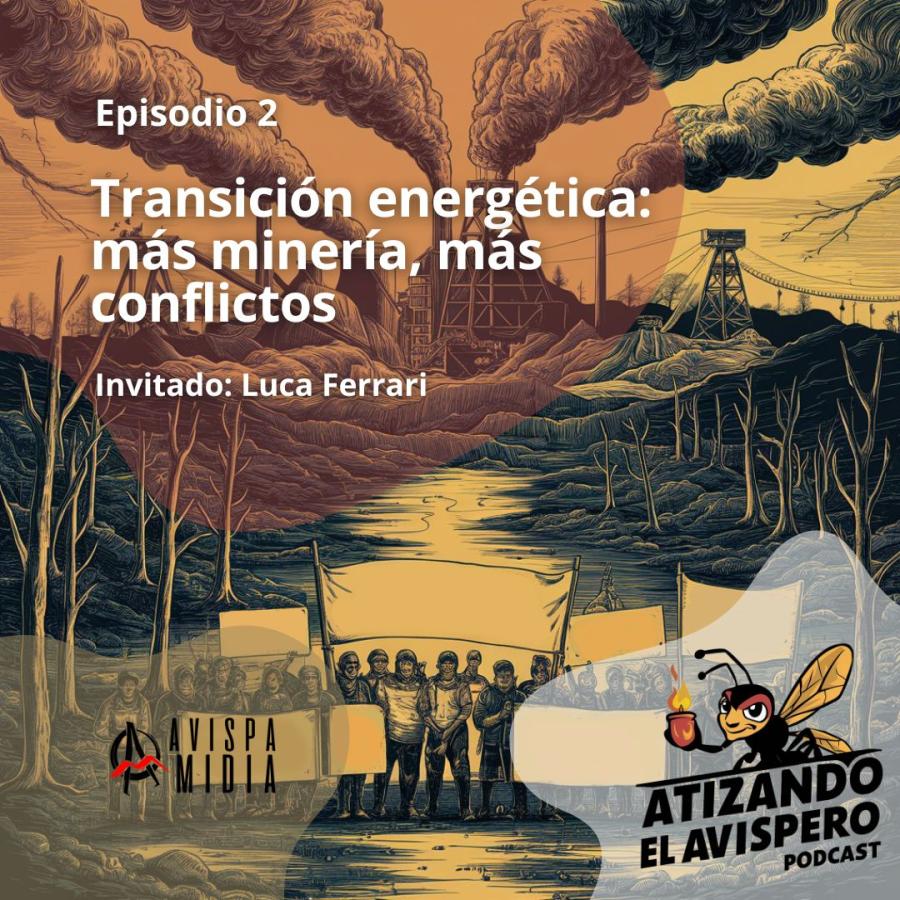
Once when I was returning from school during my elementary school days I noticed new decorations in my house. My parents had just returned from their trip to the state of Chiapas, so I figured that they had bought them there. One was a figurine dressed completely in black with its face hidden; only its eyes were exposed, and it was holding a rifle. My father told me it was Subcomandante Marcos. Sometime later my father told me about the Zapatista Army of National Liberation (EZLN). He also showed me some documentaries. That's how I learned about the Zapatista movement.
The Zapatista movement is considered a milestone in the history of the Indigenous rights movement in Mexico due to its national and international impact and achievement of public recognition for marginalized Indigenous people in Mexico, who had been excluded for more than 500 years in the Mexican constitution.
During the government of Carlos Salinas de Gortari, who served as the 60th president of Mexico for 7 years, the EZLN movement was not covered much by commercial media, and the independent, national, and foreign alternative media only focused on it in passing. The EZLN arose to bring awareness about the violations of Indigenous Peoples’ rights throughout the history of Mexico. On January 1, 1994, the Indigenous armed uprising finally aroused the interest of various media. “If we cover our faces, they will turn to see us,” was a phrase spoken among members of the EZLN—and that is exactly what happened. The media began to ask, who are they? Who leads the movement? Why do they do it?
Groups of Indigenous people demonstrated in eight different municipal seats in the state of Chiapas, questioning the government about its democratic, economic, and territorial promises. The main objective of the movement was the establishment of a participatory democracy; it was a group claiming Indigenous rights. The government's initial reaction to the EZLN was to mount a military offensive. But the movement had a lot of support from alternative media, so the government was pressured by national and international communities to meet its demands.
This is how the Clandestine Revolutionary Indigenous Committee-General Command of the Zapatista Army of National Liberation (CCRI-CGEZLN) emerged. In March 1995, Congress approved the Law for Dialogue, Conciliation, and Dignified Peace in Chiapas, which was signed by President Zedillo. This law set the tone for establishing dialogue with Indigenous Peoples. There were six proposed tables of which only one was carried out, dealing with Indigenous law and culture. It led to the government promising to recognize Indigenous Peoples in the national constitution.
The Zapatistas made the following demands in the San Andrés Accords regarding the construction of a new national legal framework:
- To legislate on the autonomy of the communities and Indigenous Peoples, to recognize the communities as entities in public law, and to guarantee the protection of the integrity of the lands of Indigenous communities under the concept of territorial integrity in the International Labor Organization Convention 169, establishing procedures for the regularization of the forms of Indigenous property and the promotion of cultural cohesion.
- The protection and preservation of natural resources. The movement proposed regulating an order of preference in which Indigenous communities are privileged in the granting of concessions to obtain the benefits of the use of natural resources.
- Inclusion of male and female Indigenous representatives in the legislative system, incorporating new criteria for the delimitation of electoral districts that correspond to Indigenous Peoples, and holding elections in accordance with the legislation on the matter.
- Guarantee of the rights of Indigenous Peoples to elect their authorities, exercise authority according to their norms within their spheres of autonomy, and the guarantee of participation of women in conditions of equality.
- Consideration of the multiculturalism of the Mexican nation, which reflects intercultural dialogue through common norms for all Mexicans and respect for the internal normative systems of Indigenous Peoples, and ensuring the obligation not to discriminate based on racial or ethnic origin, language, sex, belief, or social condition.
- Ensuring the right of Indigenous Peoples to the protection of their sacred sites and ceremonial centers and the use of plants and animals for strictly ritual use, so that Indigenous Peoples can enjoy the free exercise and development of their cultures, which includes access to media.
On February 16, 1996, an agreement was signed in the town of San Andrés Larráinzar, Chiapas, between the Government of Mexico, then represented by President Zedillo, and the EZLN, in which both parties negotiated the issues related to Indigenous representation in the Constitution. The agreement is known as the San Andrés Accords and was a tremendous achievement in the recognition of Indigenous laws and cultures. The Accords gave rise to the founding of the National Indigenous Congress, formed on October 12, 1996, and the Concord and Pacification Commission, formed in March 1995.
After several negotiations with the government from 2001-2003, the Mexican constitution was reformed, and the rights of Indigenous Peoples and Indigenous communities to self-determination and autonomy are now codified and guaranteed. Indigenous Peoples have the right to preserve and enrich their languages, knowledge, and other elements that strengthen their cultural identity.
The fourth article of the San Andrés Accords establishes that Indigenous languages are an integral part of the national cultural and linguistic heritage. The plurality of Indigenous languages is one of the main expressions of the multicultural composition of the Mexican nation. The Indigenous languages that are officially recognized are considered national languages due to their historical origin, and have the same validity as Spanish in the territories and contexts in which they are spoken.
Raising awareness was a communication and dissemination tactic used effectively by the EZLN, in large part because the movement knew how to use the media. It led to an uprising of the popular sector in Mexico, which many media outlets covered. However, the publications were often censored or contained disinformation, and there was a frequent lack of objectivity in reporting. In newspapers such as La Jornada and Reforma, their ideological positions, either in favor or against, could be ascertained based on the amount of copy published about the Zapatistas, the space they were given, the size or number of photographs, and the language used to describe them.
In the research process for this article, a Google search turned up only a handful of mentions of the EZLN from three newspapers. In 1994, the newspaper El Universal, headed by Juan Francisco Ealy Ortiz, had an ideologically diverse view and covered stories that focused on democracy. Luis Reed, Mexican historian and journalist, said that during the six-year term of President Zedillo, El Universal, along with La Jornada, Reforma, El Financiero, and Excelsior were characterized by raising alarm about the danger of ungovernability and possible national disintegration. El Universal called itself a newspaper of the center, “neither of the left like La Jornada, which is increasingly populist, nor of the right like La Reforma, which is more moderate."
Cecilia Gonzáles points out that La Reforma published that the Zapatistas trained children as guerrillas, which led the EZLN to boycott the newspaper. In contrast, La Jornada expressed absolute sympathy with the movement. Thus La Reforma positioned itself as ideologically right-wing; “a conservative newspaper [that] was not going to support the fight for Indigenous rights.”
La Jornada is run by independent journalists without large media influence. It was formed in 1984, and since then it has been associated with a left-wing ideology and an anti-regime attitude. La Jornada emerged as a project promoted by Carlos Payán and Carmen Lira Saade. It was the only newspaper that published in its entirety the communiqués of the Zapatista movement. It dedicated several columns, covers, and pages of its newspapers to them. In addition, on its website, it has dedicated a very extensive section to its history of collaboration with the movement, describing the events, statements, and responses that were obtained from the government over the years.
Communication was a powerful weapon to guarantee the progress of the peace negotiations and the vindication of Indigenous struggles. In addition to receiving coverage in the newspapers in Mexico, the EZLN created its own website—one of the first websites in Mexico—and in this way the movement gained sympathizers all over the world and prevented the Mexican army from destroying their families.
The website of the Zapatista movement, Enlace Zapatista, continues to be updated with EZLN’s latest news and statements and allows public comments. Among those comments are those who speak for and against the movement and the Subcomandante himself. It contains videos, statements, stories, and photographs, and accepts submissions. In this way, the movement appeals to the concept of citizen journalism and counteracts misinformation and disinformation campaigns.
Today, we commemorate the Indigenous movement of EZLN that opened the doors for Indigenous Peoples to claim their rights and fight for the revitalization of their languages, and to be protected and recognized by law with the right to be cared for by public institutions and respect for the plurality of Indigenous languages, worldviews, traditions, foods, clothing, spiritualities, politics, and sexuality, among other aspects.
Twenty-nine years after the armed uprising, the fight continues. The threats have a different name and face, but Indigenous Peoples’ rights, territories, homes, politics, worldviews, languages, and spirituality continue to be in danger. The existence and maintenance of the Zapatista movement has resulted in the organization of different social groups who are continually defending their rights, seeking a dialogue with the government and the Mexican political class.
Top photo by: Dal_air



